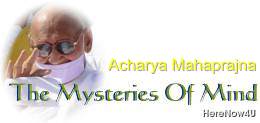
- It is difficult to collect equipment for a battle.
- One who engages himself in self-exertion will have to face struggles.
- One can avoid future actions for achieving the status of a spectator only after discernment has begun to be operative.
- Once the ideal has been clearly visualized, one gets rid of what is undesirable.
- Once the desirable thing has been achieved, the practitioner would like to remain self-disciplined, wakeful and calm, but the infiltration into him by alien tendencies will still continue and he will have to employ several means to get rid of this infiltration.
- Self-exertion is an exercise in discernment or dissociation.
- Distinction between the soul and the body,
- Distinction between desires and the soul.
- Distinction between inertia and the soul.
- Distinction between the emotions and the soul.
Development Of Energy-Tapa (Austerities)
Kayotsarga (abandonment of the body and self-awareness) is an exercise in discernment. After we have analysed an object thoroughly and distinguished one part of it from another, what remains is the existence of the object, which is transcendental and supreme. In order to arrive at ultimate truth we have to make analyses and distinctions, distinctions between the body and consciousness, between desire and consciousness, between infatuation and consciousness, between excitement and consciousness and so on. Consciousness is distinct from the body, sleep, desire, self-negligence (pramada) and excitement. The sense of this distinction is the starting-point of the journey towards self-realization. We enter into the realm of the spirit or our real existence by means of disciplining the body, hands, feet, speech and the sense-organs. Self-discipline is the means of attaining the self. Kayotsarga (abandonment of the body and self-awareness) is the first step in this direction.
The grossest means of self-realization is the human body. Breath is a part and parcel of the body. There are three sources of our actions: mind, body and speech. Breath is not an independent source. It is included in the body.
The self-exerting spiritual practitioner has to achieve kayotsarga and to bring the fickleness of the body and mind to an end. How is this to be achieved? How is the fickleness of the body to be controlled? So far as vital energy continues to circulate in the body and so far as the mind keeps the body active, the natural tendencies of the body cannot be controlled and it cannot be stabilized. In other words, kayotsarga cannot be achieved so far as the vital energy and mind are active. In order to achieve kayotsarga the mind will have to be engaged elsewhere. It will have to be eliminated from the body. Therefore, we will have to divert the mind inwards and drop it into the ocean of consciousness. In our worldly experience, consciousness remains hidden like a flame in a closed vessel. Once the mind has been soaked in consciousness or absorbed in the flame of consciousness, the body will become calm and stabilized by itself. The vibrations of vital energy and the restlessness of the mind are the causes of all the activities of the body. If vital energy and the mind are analysed towards consciousness, the body will become calm and stabilized, for it will be cut off from the sources of its activities. It will become abandoned. The body cannot be abandoned and its activities cannot be stopped until the mind has not been yoked to that state of consciousness in which the self becomes a spectator and a knower par excellence.
 Acharya Mahaprajna
Acharya Mahaprajna

